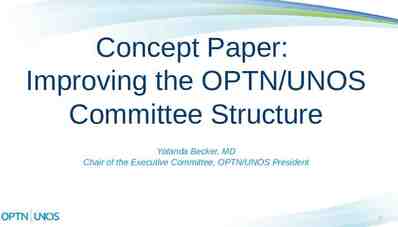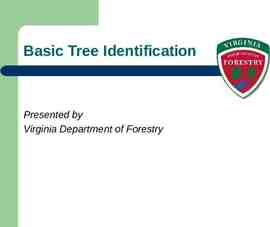Developing Exercises An outcome and task-oriented training
34 Slides2.94 MB
Developing Exercises An outcome and task-oriented training webinar December 17, 2014 Presented by: Frannie Edwards & Dan Goodrich Mineta Transportation Institute
Moderator George Whitney CESA member Former local, state and federal EM Founder of Complete EM [email protected]
CESA’s training webinars Offered on the third week of every month Conducted during the noon hour Designed and presented by CESA volunteers Focused on outcomes, tasks, and resources Includes both presentation and Q&A Archived on CESA website Benefits from member participation
Let’s get started Webinar outline Introduction Presentation Questions and Answers Wrap-up
Today’s webinar topic supports: Outcome: Understanding of HSEEP and how to create exercises. Goals: 1. History/overview of new HSEEP documents. 2. Identification of tools and tasks for exercise creation 3. Next steps in exercise development.
Presenter Frannie Edwards, PhD, CEM Professor, San Jose State U. Deputy Director, National Transportation Safety and Security Center, Mineta Transportation Institute Director, OES, San Jose 1991-2006 Emergency Services Coordinator, Irvine 1986-1991 CESA member
Presenter Dan Goodrich, MPA, CEM, MEP Lecturer, San Jose State U. Research Associate, Mineta Transportation Institute Emergency management positions with Lockheed Martin Space Systems, County of Santa Clara and City of San Jose CESA member
The outcome we desire Participants will be able to develop an HSEEPcompliant exercise based on one of the organization’s plans that will evaluate the organization’s capability to activate the plan in a real emergency
Reasons we want this outcome. Ensure that the organization’s resources are aligned to provide effective emergency response to the community Plans, personnel, equipment, facilities Enable the development of plan revisions, employee training and material resources to support readiness Meet requirements of SEMS and federal emergency preparedness grants Until you exercise you cannot know if your plans and training are workable
Acknowledgements Rod Diridon, Sr. and Dr. Karen Philbrick for their support of the development of the US DOT Exercise Handbook San Jose State University Police Department, San Jose Fire Department, San Jose Police Department and Caltrans, our exercise partners CESA Training Committee, including Masha Hovey, Jerry Quinn, George Whitney, Bob Cascone, Ray Riordan, Keith [add]
PPD-8 Changes PPD-8 (3/30/11) Replaces HSPD-8, locally driven training and exercise programs and “whole community” involvement. National Preparedness Goal (Sept., 2011) Removed color codes, replaced TCL with CC Focus on terrorist attack, cyber attack, pandemic and catastrophic natural disaster- no technological like power outage Whole Community involvement in emergency management THIRA drives new capability targets Required at state level, generates threat list Local communities select planning/preparedness focus based on local threats – no longer “all terrorism all the time” Core Capability List Based on the community’s threats, it orients its investments to acquire the core capabilities needed
What is HSEEP? Homeland Security Exercise and Evaluation Program Revised 4/16/12 to align with PPD-8, National Preparedness Goal and National Preparedness System Reduced to 2 volume guidance- see fact sheet HSEEP System Discussion-based: Seminar, workshop, game, tabletop. Action-based: drill, functional, full-scale Others as designed locally such as facilitated – see Exercise Handbook
Key tasks Select an exercise committee that is representative of each department within the organization and each outside agency participating in the exercise Select an element of a plan or a process to evaluate Obtain the participation of the appropriate “players” from within the organization and its supporting elements Select an exercise type that is appropriate to your level of training Create meaningful exercise goals Select a scenario last, so that it will appropriately exercise the plan, so that it can be evaluated against the goals
What is driving this exercise? Boss is suddenly interested in disasters Political interest in photo op, participation Contractual or grant mandate Needs driven: agency reorganization, personal estimate of need to prepare, new partners Plan driven: new plan, updated plan Training driven: validate training levels, find gaps
Executive Buy-In Executive support for the exercise Understand how the organization will benefit from the exercise Executive resource commitment to the exercise Memo to department heads and players Funding for overtime Funding for exercise materials
Things to consider when putting an exercise together. Initiate Plan Execute Monitor/Control Close What is driving this? Exercise Committee creation Goals Cold start or pre-stage C&E comm plan Hot Wash Positioning of C&E's Authority to change MSEL C&E debrief Document start and end Adding/subtracting injects After Action Report What is the funding source? Is there a commitment to a certain exercise type? Is everyone using the same definitions? What plan / procedure is being evaluated? Is this experimentation/learning opportunity? Improvement Plan Where is the organization in its training & planning? Location for exercise (inc. ingress & egress) Memorialize Documentation Who inside/outside the organization is participating? Logistical support (food, trash, signage) Who are the Controllers and Evaluators (C&E)? Meetings (C&E min.) What does "success" look like? Unavoidable artificialities Objective Timeline for exercise incl. setup & teardown OR Injects and contengency messages/situations Scenario creation Supporting documents (Explan, MSEL, etc.) Each exercise has its own peculiarities. As with ICS, use only what you need.
Select an exercise committee That is representative of each department within the organization That includes each outside agency participating in the exercise
Select an Element of a Plan, Training or Capability to Evaluate
Obtain the participation of the appropriate “players” from within the organization and its supporting elements
Select the Exercise Type Each type of exercise supports a different focus, scope and outcome Each type of exercise requires different resource sets Discussion-Based Action-Based Seminar Drill Workshop Functional Game Full scale Tabletop
Create Meaningful Exercise Goals Alert Notification To demonstrate the ability to alert, mobilize, and activate the personnel, facilities, and systems required for emergency response, and for subsequent staffing for the next shift to maintain 24-hour operations. Communications To determine the ability to establish and maintain communications essential to support response to an incident/accident and the immediate recovery, including establishing interoperable communications with first responder agencies. Emergency Public Information To determine the capability of the emergency public information system to disseminate timely and accurate emergency response information in languages and methods appropriate to the community; evaluate the ability to work with the media and maintain media monitoring and rumor control; evaluate the adequacy of the electronic signboards, travel information radio, 5-1-1 system, and agency website for maintaining timely travel information to the public.
Select a Scenario Select a recent real event from your community or a nearby community that provides the scope to meet the exercise goals. Ensure that the scenario offers a manageable set of challenges for the players. Failure generates enemies.
Tools used to achieve outcome Edwards and Goodrich Exercise Handbook HSEEP Guidance FEMA Independent Studies
Tools: HSEEP Guidance Federal guidance document for exercises Reduced to 2 volumes for easier use Describes all aspects of exercise development from the federal perspective
Tools: HSEEP Guidebook HSEEP Volumes I-III and V have been consolidated into HSEEP Guidebook Chapters aligned to each phase of the exercise planning cycle. Acronyms and Glossary in one list Sample exercise material and templates provided in HSEEP Volume IV. Documents will be aligned to each chapter and posted to the HSEEP Resource Center
Edwards and Goodrich, Exercise Handbook Free, downloadable .pdf book Project management format HSEEP 2013 version uses some PM concepts Checklist oriented Understanding of “drivers” Real world scenarios, not fantasy Structuring the exercise around what you can do/will need Identification of what resources would be needed for the different exercise types Ruled out software due to too many options (160 project management software programs) Part II is available as a Word document for easy use in designing exercises Project management checklists for each type of exercise Exercise types and planning determinants FEMA Independent Study training information, Detailed exercise goals and outcomes Example Improvement Matrix
Tools: Exercise Handbook Simplified guide to developing, holding and evaluating exercises Part II practical tools on Word format Checklist for creating each exercise type Step by step process using project management principles Scenario format for each exercise type Controller and evaluator roles Guides to After Action Review and Report, Improvement Matrix, Sample AAR/IM Specific hints and advice Glossary and acronym list 6 home and personal preparedness fliers
FEMA Independent Studies FEMA offers over 200 on-line independent study courses IS-120 Introduction to Exercises IS-130 Exercise Evaluation and Improvement IS-139 Exercise Design
Questions We’ve got 15 minutes for questions If you have not already done so, type your question into the webinar chat panel now Please keep questions on-topic We’ll read questions and answer those we can Other questions and answers will be posted at http://em-issues.org
Wrap-up [Thank presenter] [Solicit evaluations] [Remind about webinar archive and ongoing Q&A forum] [Solicit new webinar topics and outreach to new emergency managers]
Where to go for more info and help Edwards, F.L. and Goodrich, D.C. (2014). Exercise Handbook, Report 1103, http://transweb.sjsu.edu/project/1103.html Free .pdf download provides step by step exercise design guidance for all types of HSEEP exercises, including sample goals, scenarios and checklists for exercise development. Includes explanation of PPD-8 and list of resources. FEMA Independent Study Program, notably IS-130 and IS139. http:// www.training.fema.gov/is/courseoverview.aspx?code IS-130 and http:// www.training.fema.gov/is/courseoverview.aspx?code IS-139 Free on-line classes on exercise design.
Where to go for more information and help HSEEP 2013. Homeland Security Exercise and Evaluation Program. http://www.fema.gov/media-library-data/2013072 6-1914-25045-8890/hseep apr13 . pdf New HSEEP guidance. Obama, Barack. 2011. Presidential Policy Directive 8 (PPD-8): National Preparedness. Washington, DC: The White House, March 30, 2011 New National Preparedness doctrine.
Where to go for more information and help THIRA (Threat and Hazard Identification and Risk Assessment) Fact Sheet. (2012). http:// www.fema.gov/media-library-data/2013072 6-1842-25045-8735/nic faqs thira final.pdf Core Capabilities List. (2014). https:// www.fema.gov/core-capabilities
Go forth, do well, and share [email protected]







































